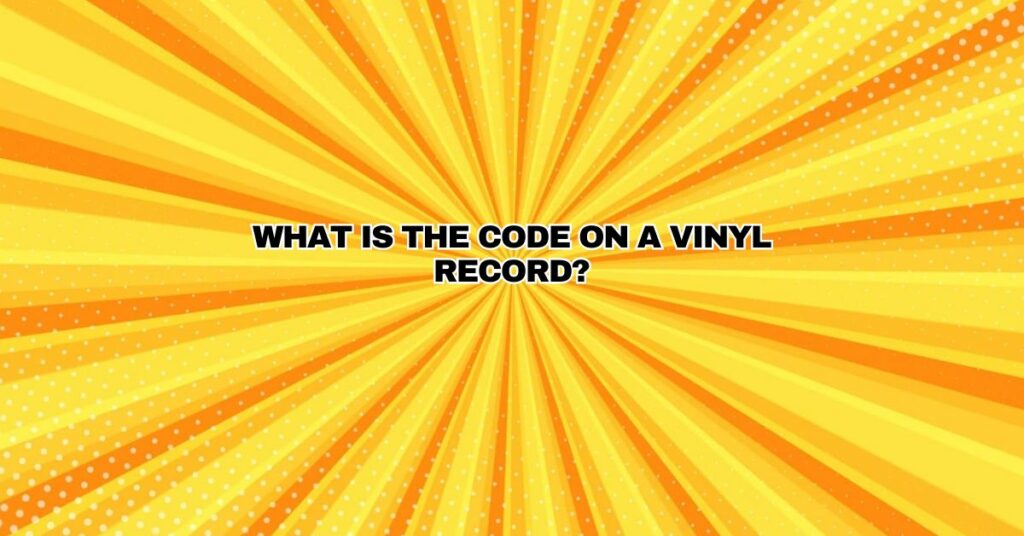Vinyl records have long been a beloved format for music enthusiasts, known for their tactile appeal and warm analog sound. Each vinyl record contains a wealth of information beyond the music etched into its grooves. One of the most cryptic elements is the matrix code or runout groove inscriptions. In this article, we’ll delve into what the matrix code on a vinyl record means, its significance, and how to decipher it.
What Is the Matrix Code?
The matrix code, often found in the runout groove area near the center label of a vinyl record, is a series of characters, numbers, and symbols that are inscribed during the manufacturing process. These codes serve multiple purposes, including identification, cataloging, quality control, and copyright tracking.
Components of a Matrix Code:
Matrix codes can vary in complexity, but they typically include the following components:
- Catalog Number: This is a unique identifier assigned by the record label or manufacturer to distinguish the release from others in their catalog. It helps retailers and consumers order the correct record.
- Side Number: Vinyl records are typically labeled with “A” and “B” to indicate the two sides of a record. This part of the code specifies which side of the record you are looking at.
- Cutting Engineer’s Initials: The cutting engineer is responsible for transferring the audio recording onto the lacquer master disc before it’s used to press the vinyl records. Their initials are sometimes included in the matrix code, signifying their involvement in the production process.
- Mastering Studio Information: The matrix code may include the name or code of the mastering studio that handled the audio mastering of the record. This information is crucial for quality control.
- Pressing Plant ID: It often contains an identifier for the pressing plant where the vinyl record was manufactured. Different plants may produce records with slight variations in sound quality and appearance.
- Special Inscriptions: Some matrix codes feature unique inscriptions, symbols, or messages that are specific to the release. These can be added for artistic or promotional reasons.
Deciphering the Matrix Code:
Deciphering the matrix code can provide insights into the history and authenticity of a vinyl record. Here’s a simplified breakdown of a typical matrix code:
- Catalog Number: This is the most straightforward part of the code, usually identifying the record label’s catalog number. It helps identify the album or single.
- Side Number: A or B indicates whether the code refers to side A or side B of the record.
- Cutting Engineer’s Initials: These initials are usually self-explanatory, representing the person who mastered the recording.
- Mastering Studio Information: This part may include the name of the studio, a studio code, or both, signifying where the audio mastering occurred.
- Pressing Plant ID: The identifier for the pressing plant helps identify where the record was manufactured.
- Special Inscriptions: Any unique symbols or messages are open to interpretation, and they can range from artistic expressions to hidden references.
Significance of the Matrix Code:
The matrix code on a vinyl record serves several important functions:
- Identification: The code ensures that the right record is matched with its proper jacket and catalog entry. It prevents mix-ups during the manufacturing and distribution processes.
- Quality Control: Matrix codes help trace the production process back to the mastering studio, pressing plant, and cutting engineer. This can be valuable for assessing sound quality and addressing issues if necessary.
- Collectibility: Enthusiastic vinyl collectors often use matrix codes to identify rare pressings, limited editions, or variations of a record. Some unique inscriptions and symbols add to a record’s collectible appeal.
- Copyright Tracking: The code can be used for copyright and royalty tracking. It helps record labels and artists monitor the use and distribution of their music.
Collecting and Analyzing Matrix Codes:
For vinyl enthusiasts and collectors, deciphering and analyzing matrix codes can be an exciting part of the hobby. It can reveal details about the record’s origin, history, and authenticity. Some collectors even document matrix codes to track down specific pressings or variations of albums they are seeking.
To accurately decode matrix codes and their associated meanings, collectors often consult databases, online forums, and reference books dedicated to vinyl record information. These resources can provide insights into the origins of the record, any special editions, and even specific characteristics of sound quality associated with different mastering and pressing plants.
In conclusion, the matrix code on a vinyl record is a fascinating and multi-purpose inscription that reveals a wealth of information about the record’s origins, production process, and authenticity. It serves practical functions in identification and quality control and adds an element of intrigue and collectibility for vinyl enthusiasts. Deciphering matrix codes can be a rewarding aspect of vinyl record collecting, allowing collectors to trace the history of their beloved records.

